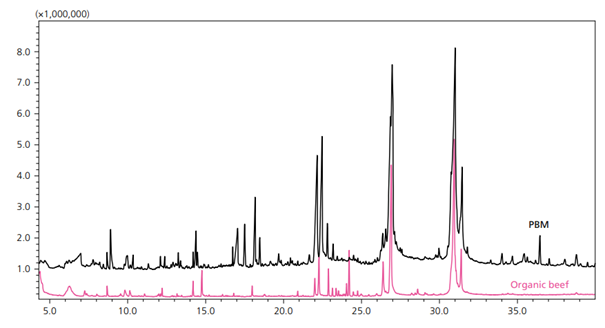
Panel discussion on...
Healthy lifestyle
Welcome in the world of alternative meat: analytical challenges and perspectives

Introduction
1) Consumers are increasingly placing health benefits at the top of their priorities. There's a noticeable shift towards more realistic health and wellness goals, such as eating healthier foods, losing weight, and reducing alcohol consumption. Interestingly, the intent to adopt a vegan diet has seen a decline, with consumers opting for more achievable lifestyle changes.
Trends such as a preference for natural and clean products, more personalization, and the digitalization of wellness offerings are gaining momentum. These trends span across various sectors, including skincare, nutrition, fitness, and retail.
Beyond personal health, there's a growing demand for sustainably produced goods and services. Consumers are looking for products that not only benefit their health but are also kind to the planet.
These trends collectively indicate a consumer base that is more informed, health-conscious, and demanding in terms of the quality, health benefits, and ethical sourcing of the products they choose to consume. Brands and manufacturers are responding by focusing on natural ingredients, clear labeling, sustainability, and personalized products to meet these evolving consumer demands.
2) While it's challenging to pinpoint a single greatest achievement given the breadth of the field, several key areas of progress stand out:
- Sustainability: there has been a dramatic shift toward sustainable ingredients and products and there are new technologies emerging that help capture valuable materials from the waste stream of other manufacturing processes.
- Personalized Nutrition: The shift towards personalized nutrition has brought about an explosion of new apps, AI related evaluations and opportunities for companies to better service the individual consumer rather than the “broad brush” condition-specific, approach of the past.
- Holistic nutrition – people understand now more than ever that everything is linked, what they put in their body shows up in their skin, hair, and joint health. Discovering and developing ingredients that serve more than one bodily system is the best way to ensure overall wellness.
4) Substantiation of claims does still play a critical role in consumer purchasing decisions, however value alignment has become increasingly more important. People want to feel good about the purchasing decisions they are making and we see that reflected in not only the purchasing decisions they are making, but the pre-purchase research being done.
5) How do consumer today judge their health status:
Please put the following parameter in order. 1 highest priority 7 lowest priority
- Mental and Emotional Well-being: stress levels, emotional balance, happiness
- Physical Symptoms, like pain, fatigue, constipation, weight gain
- Diet and Nutrition: intake of fruits, vegetables, whole grains, proteins.
- Fitness Levels: endurance, strength, flexibility
- Quality of sleep: Sleep quality and duration
- Health Tracking Devices and heart rate, sleep patterns, steps taken
- Medical Check-ups: blood pressure checks, cholesterol screenings, blood sugar tests
6) There is a noticeable trend in consumer preferences shifting away from traditional supplement delivery formats like capsules and tablets towards more innovative and engaging formats. Gummies, softgels, chewables, soft chews, and liquid shots are gaining popularity among consumers, with a significant decline in the preference for traditional formats over the past decade. This shift is partly due to "pill fatigue" and the desire for a more enjoyable consumption experience, which these alternative formats offer through their appearance, taste, and texture.
The choice of delivery format can indeed have regional and cultural nuances, similar to taste preferences. For example, gel/jelly formats have seen success in South Korea within beauty supplements, while liquid shots are popular in both Asian markets and the U.S. for their functional benefits. This suggests that cultural factors do play a role in the acceptance and popularity of certain supplement formats.
10a) Sustainability indeed has become a growing concern in the nutraceutical industry, reflecting a broader shift towards environmental consciousness among consumers and businesses alike. A significant portion of global consumers is increasingly prioritizing environmental health and its impact on the planet. This trend is underscored by data showing that 68% of global consumers prioritize environmental health, and 75% of young people express profound anxiety about climate change. The nutraceutical industry is responding by implementing climate-positive production methods and focusing on circularity and upcycling to decrease carbon footprints and improve sustainability.
10b) Are consumer looking proactively for brands which have ethical and environmental principles? Yes.
10c) We are a 100% upcycled raw material supplier.
10d) We were already producing upcycled ingredients, but we have been working to evaluate other opportunities within our processes that can help further reduce our carbon footprint and help protect and serve the global environment.
What is required to scale-up production of alternative protein sources, such as lab-grown meat and cultivated (breast/bovine) milk?
For the production of 1 kg meat approx. 1 thousand times more water is needed than for 1 kg grain. And furthermore 60% of grain production in Germany is used for feeding cattle and pork.
The development of automated production equipment for tailor-made cultured meat using 3D bioprinting will help to feed the world (4).
The 3D bioprinting technology was developed by Professor Matsusaki of the Osaka University to create muscle tissue structures. This technology is expected to be utilized in the field of food, for production of cultured meat with controlled arrangement of muscle, fat, and blood vessels.
Most of the cultured meats reported so far have a minced structure consisting only of muscle cells, making it difficult to reproduce complex structures. To solve this problem, Matsusaki and co-workers developed a 3D bioprinting technology that uses 3D printing to produce different fibrous tissues (muscle, fat, and blood vessels) and integrates them into a bundle. This technology has made it possible not only to reproduce the famous Wagyu beef, but also to delicately adjust the fat and muscle components. Osaka University and Shimadzu will jointly develop equipment to automate the production of cultured meat using this technology. (5).
What are the most effective methods for enhancing the flavor and texture of alternative proteins?There are meaningful reasons not to go for these new types of foods
Bad experience in terms of taste and texture
Raw meat on its own has little aroma; therefore, almost all aromas associated with “meatiness” are created during the cooking process by the Maillard Reaction between amino acids and reducing sugars. That reaction determines which non-volatile precursors release volatile aroma compounds. Plant-based meat (PBM), products created to resemble animal meat in both look and taste, are growing in popularity. A plant protein such as soy protein concentrate, along with colors, stabilizers, and oils, is used to successfully mimic meat flavor and texture. And, just like in animal meat, the amino acids of that protein undergo the Maillard Reaction.
Samples of PBM were run with the solid phase microextraction GC-MS and the volatile profile was compared against that of the organic beef. Similar compounds, such as fatty acids and Maillard browning reaction products, were found in both types of meat (Figure 1).
The differences can be explained by the different and wide variety of precursors present in PBM since it contains amino acids and sugars from various sources as opposed to regular meat.
There are five basic tastes, including deliciousness, which are perceived by people. The amount and kind of amino acids contribute to taste components. Of all the amino acids, glutamic acid is widely known as a component of the delicious taste. Further, the types and component ratios of amino acids largely control the flavor of food products. For example, glycine and alanine are associated with sweetness, valine and leucine with bitterness, and aspartic acid and glutamic acid with deliciousness.
The texture of food, including the sense of crispness, springiness, firmness, and the feeling on the tongue, is an important element that together with taste has an impact on the deliciousness of food. Food texture is normally evaluated using sensory tests. However, sensory tests are often difficult to reproduce, due to individual differences in people’s sensations and physical condition.
A texture analyzer can support sensory test with objective results in the form of numerical values for use in the field of food development. The texture analyzer evaluates the texture characteristics and allows a comparison of the texture of plant-based meat (PBM) and, for instance, chicken meatballs. Compared to chicken-derived products, plant-based meatballs had a higher force under loading conditions with less elasticity, which is the property to restore deformation (6). It is consistent with the result of the sensory test.

Figure 1. Overlaid Representative Chromatograms for PBM (black) and Organic Beef (pink) (6).
Panelists
References and notes
- Kaplan, A. 2021. Artificial Intelligence (AI): When Humans and Machines Might Have to Coexist. In: Verdegem, P. (ed.) AI for Everyone? Critical Perspectives. Pp. 21–32. London: University of Westminster Press. DOI: https://doi.org/10.16997/book55.b. License: CC-BY-NC-ND 4.0
Questions
1.
2.
3.
4.
5.
How have consumer awareness & demands related to healthy lifestyle changed in the last 12 months?
Where do you see the greatest scientific achievement in nutritional sciences in the last 12 months?
Are there specific health benefit areas in which significant more clinical studies are being done than in others, comparing the last 3 years?
What are the key influencers driving consumer purchasing decision for supplements or health foods? Is substantiation of claims important?
How do consumer today judge their health status?
Please put the following parameter in order 1 highest priority 7 lowest priority:
- Physical Symptoms, like pain, fatigue, constipation, weight gain
- Fitness Levels: endurance, strength, flexibility,
- Health Tracking Devices and heart rate, sleep patterns, steps taken
- Diet and Nutrition: intake of fruits, vegetables, whole grains, proteins.
- Mental and Emotional Well-being: stress levels, emotional balance, happiness
- Quality of sleep: Sleep quality and duration
- Medical Check-ups: blood pressure checks, cholesterol screenings, blood sugar tests
6.
Delivery formats can support consumer compliance and underline the technology driven approach of the brand.
a.
b.
c.
Do you see a consumer trend in preferences for certain delivery formats?
Are delivery format preference a regional, cultural aspect like taste?
Do you see a trend to carry out ingredient clinical trials using a selected delivery format as study product formulation or are most clinical studies still done in capsules?
7.
Consumer health concerns can vary widely across different regions and demographics globally. However, several common health concerns tend to be prevalent across various countries and populations due to globalization, lifestyle changes, environmental factors, and access to information.
a.
b.
Which are the key global consumer health concerns?
Do you see regional differences?
8.
There is a significant increase in the availability of apps and digital platforms focused on healthy lifestyle, particularly to support personalized approaches to mental wellbeing, metabolic support, weight management and physical fitness.
a.
b.
c.
d.
Do you see lifestyle apps as competition for supplement brands?
Do you think that these apps help to educate consumers, being more targeted when searching for supplements?
Did you consider setting up a lifestyle app to promote your supplement or your ingredient?
Did you set up a lifestyle app to promote your supplement/ ingredient and can you explore about your experience and business impact?
9.
AI (Artificial Intelligence) algorithms are today offered for various aspects of clinical trials to proof efficacy of your health ingredient or supplement.
a.
b.
c.
d.
Are consumers looking for substantiation of claims through AI driven clinical trials?
Did you consider working with an CRO specialist in AI to investigate your health ingredient or supplement?
If you applied already AI methods during the discovers/ development of your health ingredient, please share your experience and recommendation with us.
Do you think that in 2030 AI will be a manifest tool for clinical trials?
10.
A healthy lifestyle may also involve a commitment to sustainable practices for both personal and planetary health. This could include supporting ethical and environmentally conscious products.
a.
b.
c.
d.
e.
Do you agree that sustainability has become a growing concern also in the nutraceutical industry?
Are consumer looking proactively for brands which have ethical and environmental principles?
Are you looking for ethically sourced raw materials, ingredients?
Did you implement measures to establish resource-efficient processes?
Are you developing socially useful products and how do you define it?
11.
What are the major geographical differences related to healthy lifestyle trends?
a.
b.
c.
d.
e.
What are the latest trends related to claims and product forms in China?
In the U.S.
In Mexico
How are claims and dosage forms differentiated in Europe? How does your company ensure compliance with health and safety regulations in Europe?
Do you have a country where you would like to speak about trends for products?
12.
Focus clinical studies. Overall, there has been a recognized push for more gender-inclusive, geographical, and target group focused clinical research. The same trend can be seen in clinical trials for supplements or functional foods.
a.
b.
c.
d.
Please select an area you are active in and let us know which is your hot topic ingredients for 2024 for this area, based on substantiated claim, parameters, biomarkers being studied and/ or clinical study being done. Please name ingredients by scientific name and composition and not by brand name.
Please select your geographical area:
Western (EU, USA)
Asia (China, Japan, Asia Pacific)
Americas (Middle and Latin America)
Kids development/ early life nutrition/infant in Western countries and AP
Adult nutrition and prevention of developing disease
Elderly nutrition and how to support quality of life during aging
Sports nutrition, within different life decades and activity levels
References and notes























